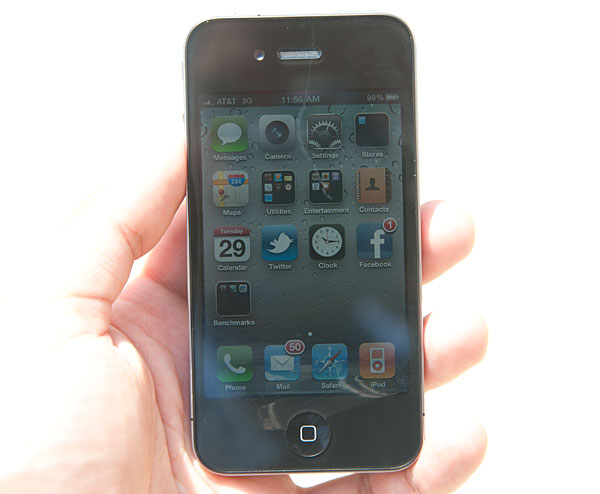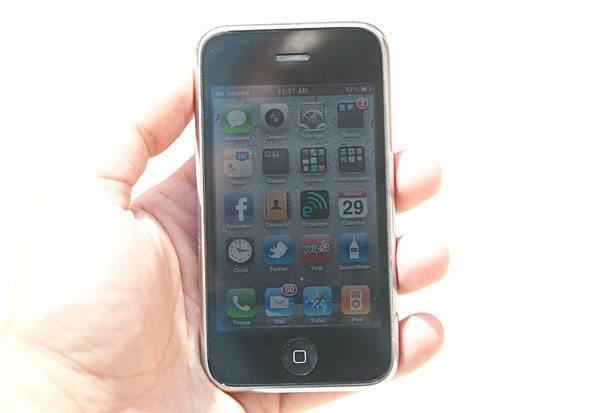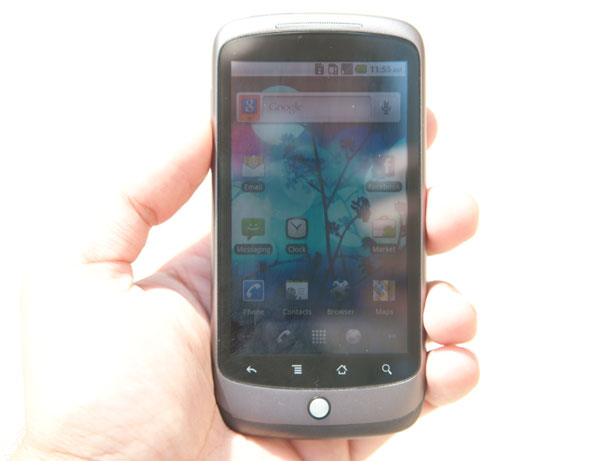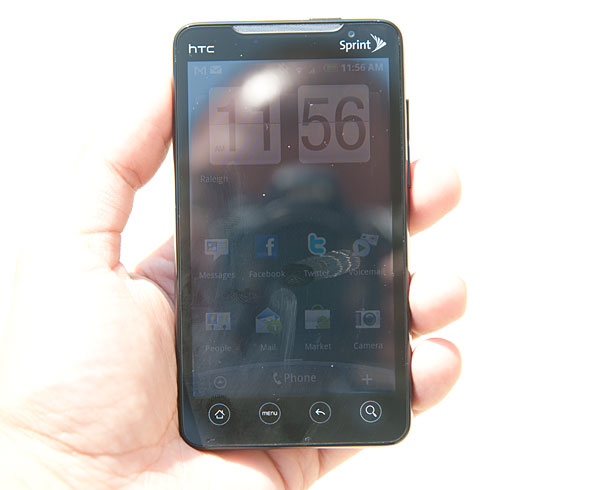Apple's iPhone 4: Thoroughly Reviewed
by Brian Klug & Anand Lal Shimpi on June 30, 2010 4:06 AM EST- Posted in
- Smartphones
- Apple
- iPhone 4
- Gadgets
- Mobile
The Display in the Sun
As we mentioned earlier, the new glass is more reflective than the 3GS' screen. In direct sunlight the 4 is somewhere in between the usability of the iPhone 3GS and an AMOLED Android phone. The photos below should help convey that.
All of the screens were set to max brightness with automatic adjustments turned off. The EVO 4G came in as the worst of the bunch, while the iPhone 3GS was the most legible.

The iPhone 4 in direct sunlight

The iPhone 3GS in direct sunlight

The Google Nexus One in direct sunlight

The EVO 4G in direct sunlight










270 Comments
View All Comments
macmanitou - Monday, July 5, 2010 - link
Hi Brian,great article, but one question just pops in my mind looking at the signal attenuation table, is the iPhone 3GS really the best? If yes I should really stick to it and probably just cancel the iPhone 4 order ;)
Sascha
isotropic - Monday, July 5, 2010 - link
Posted by: isotropic | 07/5/10 | 5:01 pm |This link Shows a Test phone TEMS sony/Ericsson K800i test phone (cost 2500+ Euro) being given the grip of death. A test done in a few minutes. It shows at a given point up to 16 dB losses by being held tightly as I have seen people doing it on the new iPhone. Not saying the iPhone could not have a problem, I don’t own one. But the iPhone is not alone for sure on this one. And Apple’s latest explanation seems pretty valid to me
http://www.youtube.com/watch?v=OWpGOxyEoZc&fea...
Akv - Monday, July 5, 2010 - link
I don't mind being locked in the Apple network for my iPod, because I find iTunes a quite convenient solution. However for a professionally strategic device like my cell phone, I would prefer a more independent solution.Besides, I still think it doesn't bring enough for the price. I could buy an excellent netbook for less than that price, and I would still have some money left for a simple but efficient clamshell phone.
ifartinyoutdirection - Monday, July 5, 2010 - link
It is a featurehttp://henriko.se/extern/iphone4buttonsandcontrols...
davehutch - Tuesday, July 6, 2010 - link
Your screen captures don't actually reflect what is being recorded. The video capture screen is a full-screen version that is not showing the correct ratio. the screen should be double-tapped for a tru representation and yes, the video angle of view is indeed smaller than the still image angle of view.please see my post here:
http://forums.macrumors.com/showpost.php?p=1044575...
for additional screenshots and comments.
r2d2droid - Tuesday, July 6, 2010 - link
Interesting. . . but I still want a droid.estarkey7 - Tuesday, July 6, 2010 - link
Why didn't you use Sprint's Everything plan pricing? For $99.00+$10.00 for the Evo 4g tax you get unlimited EVERYTHING, now add in tethering and see where that brings Sprint in comparison with AT&T and Verizon.Different ballgame all together, because 900 min is nothing. I talk 1200+ every month.
RadioGuru - Tuesday, July 6, 2010 - link
Hello guys. Thanks for the review. I have a quick question. Your wrote that "To generate these numbers, I measured at least 6 times and took the average"I wonder, did you convert the dBm number to linear, took the average and the recalculated the numbers back to dBm, or took the average using the dBm values. If you did the later, the numbers are completely wrong.
Your testing is better than most of what I have seen online so far, but real engineering testing has revealed that the TIS (Total Isotropic Sensitivity) of iPhone4 in Free Space is better than the 3GS, which is great!!!! but.....and here comes the big but....phamtom head testing of WCDMA 1900 TIS/TRP spec testing has shown a degradation of close to 30 to 40 dB in chamber testing. Which means a controlled lab environment...not a cowboy lab testing like the one you used. Sorry, I respect your work and I support what you do...but this time of evaluation requires far more engineering power.
in WCDMA/HSDPA systems, a call dropped is usually driven by reverse link limitaiton. Therefore engineers also consider TRP (Total Radiating Power) to measure antenna performance. in the case of iPhone4, TRP degradation due to HAND+HEAD is close to 40 dB, which will kill the call or increase drop calls or reduce data througput performance.
By the way, BAR maping using SNR makes sense for HSDPA data calls. GSM calls should use RSSI.
jacobdrj - Thursday, July 8, 2010 - link
You rock.dalebeal - Friday, July 9, 2010 - link
This is the most comprehensive review I have read - and I've read a lot of them. Thank you!